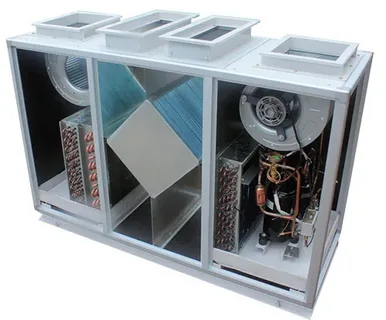In an era where energy efficiency and indoor air quality are at the forefront of homeowners’ concerns, home heat recovery systems offer a practical solution that addresses both needs. These systems are designed to improve ventilation, reduce energy consumption, and maintain a comfortable indoor environment all year round. With residential heat recovery, you can capture and recycle heat that would otherwise be wasted, enhancing the overall efficiency of your home’s heating and cooling processes.
Heat recovery systems are becoming increasingly popular as more people seek to reduce their carbon footprints while keeping energy bills in check. A whole-house heat recovery system provides excellent temperature control and promotes better air quality by constantly circulating fresh air and removing stale air from the home.
This article will explore how heat recovery systems work, their benefits, and how they can be integrated into your home for maximum energy savings and comfort.
What is a Home Heat Recovery System?
A home heat recovery system is a device that captures heat from the exhaust air in your home and transfers it to the incoming fresh air, ensuring minimal energy loss while maintaining a comfortable indoor temperature. These systems are designed to work with your existing HVAC system, making them an effective addition to any home looking to reduce energy consumption.
How Does a Heat Recovery System Work?
A heat recovery ventilation system uses two airflows: exhausting stale indoor air and bringing in fresh outdoor air. These two air streams pass through a heat exchanger, transferring heat from the outgoing air to the incoming air. The result is fresh air being brought into the home without losing valuable heat.
Key Components of a Heat Recovery System
- Heat Exchanger: The system’s core component transfers heat between air streams.
- Fans: These move air in and out of the home, ensuring a constant supply of fresh air.
- Filters: Clean the incoming air to remove dust, pollen, and other pollutants, improving indoor air quality.
- Ductwork: Carries the air throughout the home, connecting the system to various rooms.
By using these components together, heat recovery systems reduce the load on your HVAC system, helping it operate more efficiently and lowering energy bills.
The Benefits of a Home Heat Recovery Ventilation System
Home heat recovery ventilation system offer many benefits, from energy savings to improved indoor air quality. These systems are a game-changer for homeowners looking to create a more sustainable and comfortable living environment.
Improved Energy Efficiency
One of the most significant advantages of installing a heat recovery system is increased energy efficiency. These systems reduce the energy needed to heat or cool your home by capturing and reusing heat from the exhaust air. This lowers your energy bills and helps reduce your home’s overall carbon footprint.
Bullet Points: Energy Efficiency Benefits
- Reduces energy consumption by recycling heat
- Lowers monthly heating and cooling costs
- Improves the efficiency of HVAC systems
- Contributes to a more eco-friendly home
By installing a whole-house heat recovery system, you can enjoy year-round energy savings while maintaining a comfortable indoor climate.
Enhanced Indoor Air Quality
In addition to improving energy efficiency, heat recovery systems significantly enhance indoor air quality. These systems provide continuous ventilation, ensuring a constant supply of fresh outdoor air while removing stale, polluted air from the home. This helps reduce indoor air pollutants such as dust, allergens, and volatile organic compounds (VOCs), which can impact your family’s health.
Health Benefits of a Heat Recovery System
- Reduces the concentration of indoor pollutants
- Prevents mold growth by controlling humidity levels
- Provides a consistent supply of fresh air for a healthier living environment
For families with asthma or allergies, a home heat recovery ventilation system is an excellent way to improve indoor air quality and reduce the risk of respiratory issues.
Residential Heat Recovery Systems: Perfect for Modern Homes
Residential heat recovery systems are ideal for modern homes prioritizing energy efficiency and comfort. Whether building a new home or upgrading an older property, these systems can seamlessly integrate into your existing HVAC setup, providing numerous benefits without disrupting your home’s design or functionality.
Energy-Efficient Homes and Heat Recovery
Many modern homes are built with energy efficiency in mind, featuring airtight construction to minimize heat loss. While this helps reduce energy consumption, it can also lead to poor indoor air quality if proper ventilation is not maintained. A home heat recovery ventilation system provides the perfect solution by offering ventilation without sacrificing energy efficiency.
How Heat Recovery Works in Energy-Efficient Homes
- Provides continuous ventilation in tightly sealed homes
- Reduces the need for energy-intensive heating and cooling
- Improves indoor comfort by maintaining consistent temperatures
Residential systems are particularly beneficial in eco-friendly homes, helping you meet your energy efficiency goals while maintaining a healthy indoor environment.
Reducing Heating Costs in winter
Homeowners’ heating costs can be a major concern during the colder months. A whole-house heat recovery system helps reduce these costs by capturing heat from the outgoing air and transferring it to the incoming fresh air. This reduces the demand on your heating system, allowing it to operate more efficiently and lowering your monthly heating bills.
Bullet Points: Winter Heating Benefits
- Recovers up to 90% of heat from exhaust air
- Reduces reliance on traditional heating methods
- Lowers energy bills during the winter season
- Enhances indoor comfort by maintaining consistent warmth
Efficient Cooling in summer
Just as home heat recovery systems help reduce heating costs in winter, they also improve cooling efficiency in summer. By exhausting warm indoor air and bringing in cooler outdoor air, these systems help maintain a comfortable indoor environment without overworking your air conditioner. This leads to energy savings and a more pleasant indoor climate during the hot summer.
Whole House Heat Recovery Systems: A Comprehensive Solution
A whole-house heat recovery system provides ventilation and energy recovery for the entire home, ensuring that every room benefits from improved air quality and temperature control. These systems are designed to handle larger volumes of air, making them suitable for both small and large homes.
How Whole House Heat Recovery Systems Work
A whole house heat recovery system operates by continuously exchanging air indoors and outdoors. The heat exchanger captures heat from the exhaust air and transfers it to the fresh air in the home. This ensures that the home remains well-ventilated without excessive heating or cooling.
Benefits of Whole House Heat Recovery
- Provides consistent temperature control throughout the home
- Improves air circulation in all rooms
- Reduces energy costs for the entire household
- Enhances overall comfort and air quality
With a whole-house heat recovery system, homeowners can enjoy a more energy-efficient and comfortable living environment, regardless of season.
Integration with Existing HVAC Systems
One of the best things about residential systems is their ability to integrate seamlessly with your existing HVAC system. This makes them a convenient and cost-effective addition to homes already equipped with heating and cooling systems.
Compatibility with Different HVAC Systems
- Works with both forced air and radiant heating systems
- Compatible with air conditioning units and heat pumps
- It can be easily retrofitted into older homes
By working with your HVAC system, a home heat recovery ventilation system ensures that your home stays comfortable and energy-efficient throughout the year.
How to Choose the Right Heat Recovery System
When selecting a heat recovery system, several factors must be considered to ensure that you choose the right one for your home. From the size of your home to your energy efficiency goals, finding the right system will help you maximize the benefits of heat recovery.
Consider Your Climate
The type of heat recovery system you choose will depend on the climate in which you live. For homes in colder climates, a system that focuses on heat recovery during winter is essential for minimizing heating costs. In warmer climates, a system that provides cooling efficiency will help reduce the need for air conditioning.
Size of Your Home
The size of your home plays a significant role in determining the type of whole-house heat recovery system you need. Larger homes require more powerful systems that can handle greater volumes of air, while smaller homes can benefit from more compact models.
Energy Efficiency Goals
If your primary goal is to reduce energy consumption, look for systems that offer high-efficiency ratings. Residential systems with a high recovery efficiency ratio (RER) are designed to recover the most heat from exhaust air, providing maximum energy savings.
Maintenance and Durability
When investing in a home heat recovery ventilation system, choosing a low-maintenance and durable system is important. High-quality systems are designed to last for years with minimal upkeep, ensuring you get the most out of your investment.
Maintenance Tips for Optimal Performance
- Clean or replace filters regularly to maintain air quality
- Schedule annual inspections to ensure the system is operating efficiently
- Keep vents clear of obstructions for proper airflow
By following these simple maintenance tips, you can extend the lifespan of your heat recovery system and ensure it continues to provide energy savings and improved air quality.
Conclusion
A home heat recovery system is essential to any modern home, offering enhanced energy efficiency, improved indoor air quality, and cost savings. Whether building a new home or upgrading your current HVAC system, a whole-house heat recovery system provides a comprehensive solution for maintaining a comfortable and sustainable living environment.
Frequently Asked Questions (FAQs)
What is the difference between home heat recovery and ventilation systems?
A heat recovery system provides ventilation and captures and recycles heat from the exhaust air. This makes it more energy-efficient than traditional ventilation systems, which exchange indoor and outdoor air without recovering heat.
How much energy can I save with a whole-house heat recovery system?
A whole-house heat recovery system can recover up to 90% of the heat from exhaust air, significantly reducing the energy required to heat or cool your home. This can lead to up to 50% savings on your HVAC energy costs.
Is a home heat recovery system suitable for all types of homes?
Home heat recovery systems suit many homes, including new builds and older properties. They can be easily integrated into existing HVAC systems, making them a convenient and cost-effective solution for improving energy efficiency and air quality.
How often should I clean or replace the filters in my heat recovery system?
Filters in your heat recovery system should be cleaned or replaced every 3 to 6 months, depending on usage. Regular maintenance ensures the system operates efficiently and maintains good indoor air quality.
Can a residential heat recovery system help with moisture control?
Yes, residential heat recovery systems help control indoor humidity levels by exhausting moist, stale air and bringing in drier, fresh air. This helps prevent moisture buildup, reducing the risk of mold growth and improving overall air quality.




